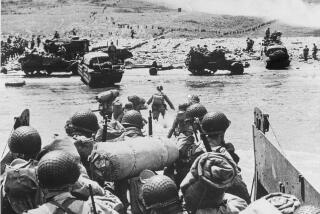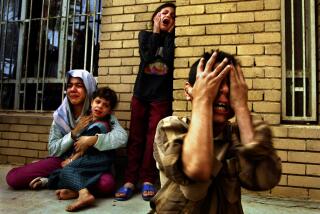Dog Bites Man in Baghdad
- Share via
Listening to the gloomy news from Iraq, I can’t help but wonder how today’s news media might have covered D-day. I can just imagine the story: “More than 8,000 Allied servicemen were wounded, 3,000 of them fatally, during an assault on Normandy beaches yesterday. Despite those heavy casualties, almost all of France remains under Nazi occupation. The supreme Allied commander, Gen. Dwight D. Eisenhower, claimed that everything had gone according to plan, but a number of retired military officers suggested that the invasion is in grave danger of failing.”
I don’t mean to make light of the casualty figures from Iraq or to minimize the dangers and challenges that U.S. troops face there. Every death is a tragedy, every service member lost is one too many. And it’s not just Americans who are being murdered. Almost all the victims of Monday’s car bombings in Baghdad were Iraqis.
But as awful as the car bombings and mortar attacks and roadside ambushes are, it’s important to keep things in perspective, which is something the news media have a tough time doing. During the “major combat” phase in Iraq, which ended May 1, the U.S. lost 115 soldiers to enemy fire. Since May 1, we have lost 113 more. In fairness, it must be added that more than 700 have been wounded since May 1, many severely, and that dozens more have died from accidents or other causes. But so far, Saddam Hussein and his gang have killed just 228 Americans.
This isn’t Vietnam (47,355 battle deaths). It’s not even the Spanish-American War (385).
For purposes of comparison, I went to the Defense Department Web site that lists U.S. military deaths from all causes. Look at the figures and you see that 1,007 service people died last year, only 17 of them in combat (presumably in Afghanistan). The other 990 were victims of accidents (538), illness (178), suicide (130), homicide (46) and causes yet to be determined (98). Assuming that the noncombat death figures for this year will be roughly similar to last year’s, it appears likely that far more service people will have died of accidents or illness than from Iraqi bullets and bombs.
Other national statistics add to the context. According to the National Law Enforcement Officers Memorial Fund, 114 police officers have died in the line of duty this year, almost exactly the number of service people who have been killed by Iraqi insurgents since May 1. And more than 41,000 people are killed on the nation’s highways every year, according to the Department of Transportation. So during the last six months, while more than 300 Americans were dying in Iraq, more than 20,000 were dying on the roads at home.
Clearly the amount of violence in Iraq is unacceptable, and more needs to be done to curtail it. The point is simply that the myopic media are focusing far too much on counting casualties and not enough on assessing the larger state of the campaign.
The frenzy reminds me of the way local TV newscasts cover major American cities: “If it bleeds, it leads.” In general, the news is a catalog of horrors -- child abuse, murder, celebrity rapes and other transgressions. No one bothers to announce: Oh, and by the way, millions of people went to work yesterday, ate lunch, came home, watched TV and went to sleep. That’s not considered news, and rightly so when covering L.A. or New York.
But the fact that such normality is returning to Iraq is news.
When I visited Iraq in August, I was surprised to see crowded streets where people were calmly going about their business. Nothing in the media had prepared me for this. Since August, even more progress has been made. Iraq has more electricity than it did under Hussein; yet after obsessively reporting on electricity woes during the summer, the news media is all but silent about how these concerns have been addressed.
By all means, report on terrorist attacks. But don’t lose sight of the bigger picture.
Max Boot is a senior fellow at the Council on Foreign Relations and author of “The Savage Wars of Peace: Small Wars and the Rise of American Power” (Basic Books, 2002).
More to Read
Sign up for Essential California
The most important California stories and recommendations in your inbox every morning.
You may occasionally receive promotional content from the Los Angeles Times.













